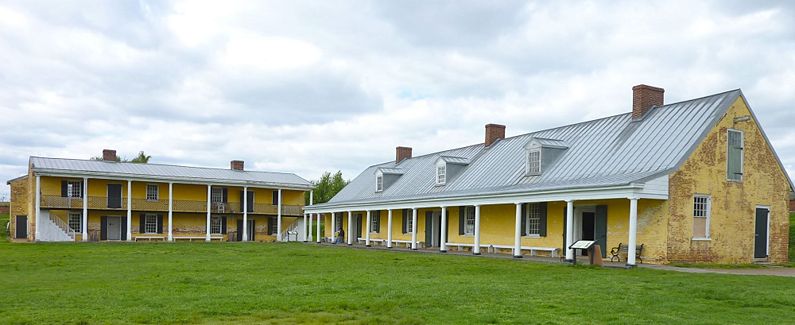Fort Mifflin
|
Fort Mifflin (1772-1962) - An Revolutionary War Coastal Fort first established as Mud Island Fort in 1772 on the Schuylkill River, below Philadelphia on Mud Island, Philadelphia County, Pennsylvania. Named Fort Mifflin in 1795 after Major General Thomas Mifflin, Continental Army, first Governor of Pennsylvania. Turned over to the City of Philadelphia in 1962.
Colonial Period (1630-1775)Construction began on a fort at Mud Island in 1772 under the direction of British Captain John Montresor but the construction was not completed and work was suspended. Revolutionary War (1775-1783)Following the signing of the Declaration of Independence in 1776, the city of Philadelphia completed construction on the Mud Island Fort and Fort Mercer on the other side of the river. British forces took control of the Philadelphia area in 1777 and laid siege to both forts forcing them to evacuate the fort after an intense artillery barrage. The British siege was led by the same British officer, Captain John Montresor, who had originally designed the Fort at Mud Island. The Americans suffered 250 killed or wounded of the 450 or so defenders. The fort was evacuated on 15 Nov 1777 and was in left in ruins. First System (1794-1808)A new fort was planned for Mud Island as a part of the 1794 First System plan. Construction began in 1794-1795 on the First System fort and it was named for Major General Thomas Mifflin in 1795. The new fort was designed by Pierre Charles L'Enfant as chief engineer, he was replaced by Lieutenant Colonel Stephen Rochefontaine in 1798. Using Pierre L'Enfant's plans Rochefontaine built out the fort as 29-gun bastioned masonry work, finished the commandants quarters, and six casemates designed to house a barracks and the headquarters as well as three for storage. The work was completed in 1801. Second System (1808-1816)Fort Mifflin was repaired in 1808 as a result of the 1807 Second System Plan. The post was virtually abandoned after the War of 1812 until about 1837 when repairs were supervised by Captain Richard Delafield, U.S. Corps of Engineers. U.S. Civil War (1861-1865)Fort Mifflin was used as a military prison during the U.S. Civil War. The larger casemates housed Confederate prisoners while three smaller casemates were used to house political prisoners. The fort had a maximum prisoner capacity of only 250 and the most it housed at one time was 215. There were 42 escapes and 3 prisoner death recorded. Work on several additional batteries was begun in the 1870s but is unclear if the work was completed or if the batteries were armed. The batteries included a nine-gun exterior battery and a six-gun mortar battery. Additional work built three guns and a magazine into the demilune and five guns with two magazines into the parapet. The old fort was disarmed and partially dismantled in 1904. It was designated a National Historic Landmark in 1915 and restored from the original plans in 1930. World War II (1941-1945)During World War II anti-aircraft guns were emplaced at Fort Mifflin to protect the Philadelphia Naval Shipyard and the Fort Mifflin Naval Ammunition Storage Depot. Coast Artillery units were assigned to the old fort. The post was deeded back to the City of Philadelphia in 1962. Current StatusFourteen restored historic structures constructed from 1778 to 1875, including an Enlisted Barracks, Officer’s Quarters, Blacksmith Shop and the casemates.
See Also: Sources:
Links: Visited: No
| ||||||
